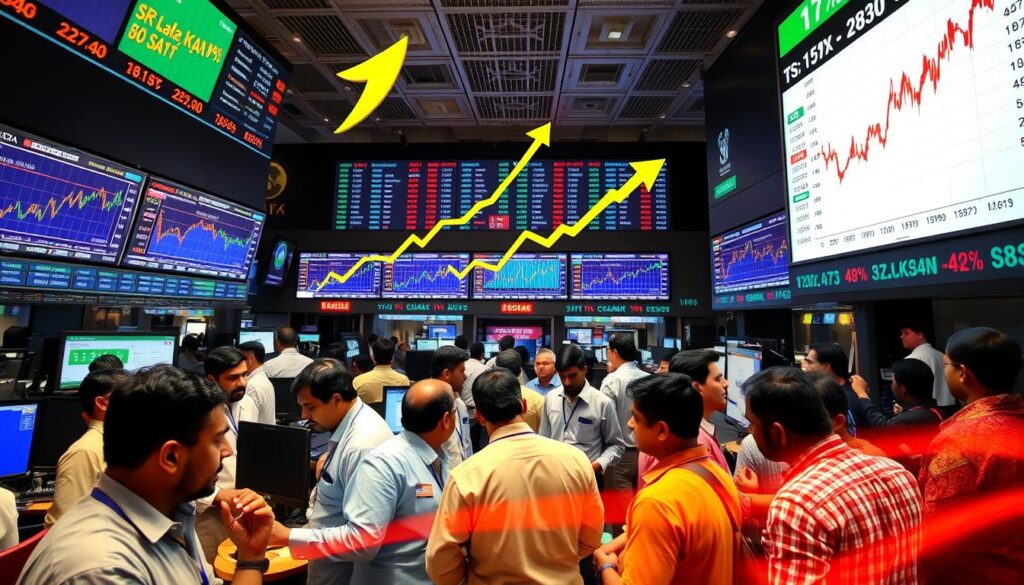Sri Lanka’s Foreign Reserves Rebound to $5.5 Billion

Sri Lanka has faced tough times, but it’s making a comeback. The nation’s foreign reserves reached $5.5 billion by. This shows stability is returning, thanks to effective policies and global teamwork.
Rebuilding international currency reserves was a huge task, especially after the pandemic’s hit. By focusing on strong fiscal strategies and important reforms, Sri Lanka is moving towards financial wisdom.
The nation is now seeing signs of improvement in many areas. This progress brings hope for its economic future. Sri Lanka’s smart response to global economic challenges has earned it praise for its financial strategies.
Impact of Historical Economic Challenges on Sri Lanka’s Reserves
Sri Lanka has faced many economic challenges, including the COVID-19 pandemic. These have greatly changed its financial path and economic growth forecast. The country’s central bank balance and monetary policy implications have been heavily affected. The crisis times have greatly disturbed Sri Lanka’s reserves.

The COVID-19 Pandemic’s Influence on Tourism and Growth
The tourism sector is vital for Sri Lanka’s economy but suffered greatly due to the pandemic. The World Bank had high hopes, but reality showed a sharp drop. Tourism income fell from an average of $3,682 million to just $507 million in 2021. This big loss hurt the foreign exchange rates and international currency reserves.
Energy and Food Crisis: Spending Spikes and Revenue Declines
After the pandemic began, Sri Lanka faced a crisis in energy and food. The government had to spend more to help its people. High spending and lower income, especially from energy, put more pressure on the central bank balance. This made it hard for foreign reserves to rebound to $5.5 billion by April 2024, showing how global and national economies are linked.
However, spending less on fuel imports helped a bit. It indirectly stabilized foreign reserves by reducing money flow out.
Consequences of Reliance on Domestic Financing Amid Global Downturn
Lower prices of International Sovereign Bonds made Sri Lanka use more domestic financing. This led to a big increase in the Central Bank of Sri Lanka’s credit to the government. It shows a move towards a focus on domestic finance, which is key for monetary policy implications. Yet, it also shows weaknesses in local finance during global economic problems.
Domestic economic activities got a small boost from easier monetary policies. There was a small rise in credit for the private sector, helping to slowly improve economic activities. The World Bank’s loan is crucial for balanced growth. Yet, it’s a delicate balance to maintain.
The crisis times have offered important lessons on Sri Lanka’s financial and economic strategies. These strategies are crucial to stabilize and slowly improve the nation’s reserves and overall economic well-being.
Foreign Reserves Rebound to $5.5 Billion by April 2024
In a world where markets and economies are always changing, Sri Lanka shows hope. Its financial stability indicators have sprung back up. This is a key sign that things are getting better for the country’s money matters. First Capital Research tells us that by April 2024, Sri Lanka’s foreign reserves hit $5.5 billion. This big improvement is seen across Asia-Pacific, showing that the government’s smart choices are paying off.
By sticking it out through tough times, Sri Lanka is nearer to its growth goals. The boost in foreign reserves is crucial. It helps keep important imports coming and guards against sudden money problems. This success comes from wise policy decisions and working closely with international groups, like the IMF. Also, policies like the interim debt standstill have been vital in keeping the economy stable.
Now, Sri Lanka might get more help, with an extra $1.2 billion possibly coming from G-20 countries in 2020. This could make the country’s money situation even better. A big part of this brighter future is thanks to more tourists coming, especially from Europe and Asia-Pacific. This jump in visitors brings in more cash and proves that new government plans and visa rules are working well. For those looking to dive deeper into how Sri Lanka is managing its debts and boosting tourism, check out more info here and here.
So, reaching $5.5 billion in foreign reserves is not just good news; it’s a major step forward. It shows Sri Lanka is serious about handling its finances wisely and planning for the future. This matches OMP Sri Lanka’s goal of keeping everyone informed about the country’s progress.





